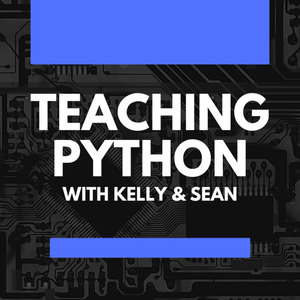Episode 31
The School of 2024
November 11th, 2019
46 mins 31 secs
Tags
About this Episode
Can you belive it's only been five years since Alexa launched? Or that identifying birds in photos was considered a hard problem for machine learning? In this episode, Kelly and Sean discuss plausible trends in machine learning, artificial intelligence, augmented and virtual reality, and data science that we may see in schools by 2024. We focus on 5 areas from microscale in the classroom to macro across the entire educational system.
- Trends in the Computer Science classroom
- Integration into other subjects
- Reducing Teacher Workload
- For Student Access to Tools
- As a School-wide Initiative
It's amazing to think that many problems in Machine Learning were considered hard just 5 years ago. What will the next 5 years bring?
Support Teaching PythonEpisode Links
- Collapsing Sith Lightsaber (Removable Blade) by 3DPRINTINGWORLD - Thingiverse — This Lightsaber has a removable collapsing blade that can be printed separately in a different color. The hilt is designed with a screw on cap which allows the blade to be inserted after its printed. Prints without supports, but you will need a printer capable of printing the hilt 205mm tall.
- Becoming Homeless: A Human Experience | VHIL — The Fundamental Attribution Error, as coined by Stanford Psychologists, describes how we blame others when bad things happen to them, but blame the external situations when bad things happen to us. There is a misconception that losing one's home is due to who you are and the choices you make. Becoming Homeless: A Human Experience seeks to counter this irrational tendency.
- Socratic by Google on the App Store — Need to get unstuck? Socratic can help! This learning app, powered by Google AI, helps you understand your school work at a high school and university level. Ask Socratic a question and the app will find the best online resources for you to learn the concepts. Socratic supports most high school subjects, with more coming soon!
- Google Translate’s instant camera translation gets an upgrade — Google Translate allows you to explore unfamiliar lands, communicate in different languages, and make connections that would be otherwise impossible. One of my favorite features on the Google Translate mobile app is instant camera translation, which allows you to see the world in your language by just pointing your camera lens at the foreign text.
- Math Games | Mangahigh.com — Get your students excited, engaged and excelling at maths and coding! Adaptive quizzes, innovative games and social competitions Aligned to international curricula Real-time analytics with AI support for differentiation
- Amazon.com - Neato Botvac D4 Connect Blk - — rners, and corners are where the worst dirt hides. Our industry-leading design gets you a complete floor clean LaserSmart mapping - D4 technology intelligently navigates and maps your home, cleaning in straight lines instead of a random pattern -- so you never miss a spot Masterful on multiple surfaces - Neato D4 conquers any surface, from carpet, to hardwood, to kitchen tile. Intuitive operation and interface. Neato is simple to use. Our focus has always been on out-of-the-box, one-button, perfect cleaning. Clean winner in innovation. Get laser navigation, no-go lines, 70% bigger combo brush, smart-home interaction, app support, and most of all. . . real, autonomous, robotic vacuuming!
- Amazon.com: AWS DeepLens (2019 Edition) – deep learning-enabled video camera for developers: Amazon Devices — Learn the basics of deep learning - a machine learning technique that uses neural networks to learn and make predictions - through computer vision projects, tutorials, and real world, hands-on exploration with a physical device. AWS DeepLens lets you run deep learning models locally on the camera to analyze and take action on what it sees.
- Alexa in Education — Amazon Alexa is ushering in a new era of technology. One where students, educators, and parents can use their voice to interact with technology that deepens learning, provides access to critical information, and saves time. With Alexa, students can track upcoming events on their calendar, get study resources, or make an appointment with a guidance counselor – all without having to open their computer. Teachers can use Alexa to prepare for upcoming lessons, while administrators can quickly access important information like enrollment statistics.
- Raiders of the Pottery GAN: Using 3D Generative Adversarial Networks for Data Augmentation | SciPy - YouTube — Reassembly of 3D fragmented objects from a collection of hundreds of randomly mixed fragments is a problem that arises in several applied disciplines, such as archaeology, failure analysis, paleontology, etc. In this talk we will walk through the pipeline of 3D data generation in archaeological studies, from pre-processing of images, moving from 2D to 3D space, and finally the training and evaluation of generative adversarial networks in Python for 3D meshes corresponding to Iberian vessels. We will report several python libraries (scikit-image, pytorch, visdom, etc.) and how they are used in this particular pipeline. The main goal of augmenting our dataset in 3D is to perform fragment part identification and vessel reconstruction.
- The internet will continue to make life better | Pew Research Center — A large share of respondents predict enormous potential for improved quality of life over the next 50 years for most individuals thanks to internet connectivity, although many said the benefits of a wired world are not likely to be evenly distributed.
- Artificial Intelligence Applications to Support K–12 Teachers and Teaching: A Review of Promising Applications, Challenges, and Risks | RAND — Recent applications of artificial intelligence (AI) have been successful in performing complex tasks in health care, financial markets, manufacturing, and transportation logistics, but the influence of AI applications in the education sphere has been limited. However, that may be changing. In this paper, the author discusses several ways that AI applications can be used to support the work of K–12 teachers and the practice of teaching by augmenting teacher capacity rather than replacing teachers.
